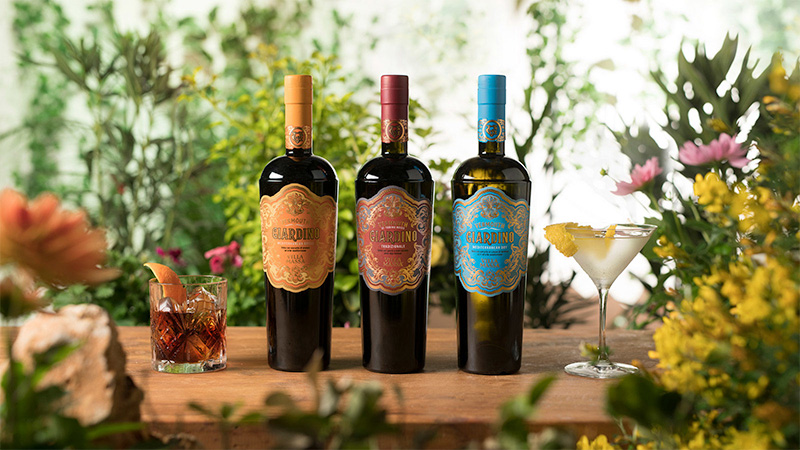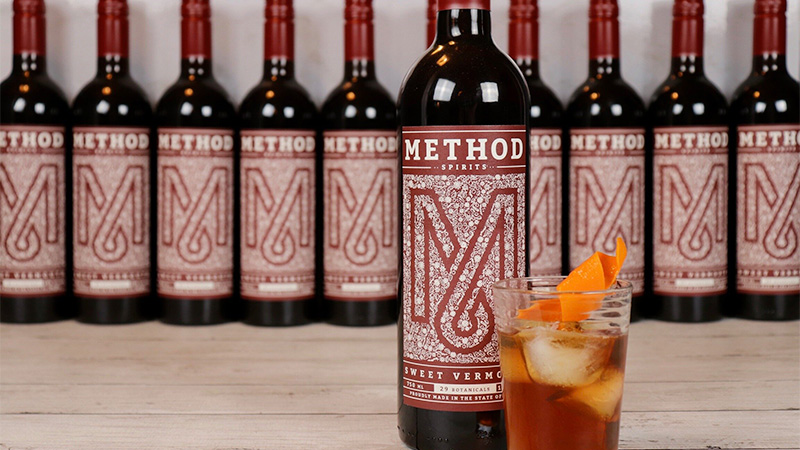For all the bad dates, poor decisions, and boorish behavior, many great ideas and lasting relationships are born at the bar. But when it comes to reading the room and observing what people are drinking, bartenders are on the front line of guiding people to a quality experience, serving as equal parts gatekeepers and tastemakers. And these days you’re more likely to find your local bartender balancing their shifts with an industry-adjacent pursuit in the hopes of these passionate side-hustles leading to successful business ventures.
In recent years, a new batch of bartenders have turned to Italian-born vermouth as inspiration for their own modern take on a category rich with history but ripe for reinvention. And while vermouth plays a key role in some of the world’s most popular cocktails (the Martini, Manhattan, and Negroni, to name a few), it’s still in deep need of demystification and continued education on everything from production methods to proper storage. It may be a bold bet to set out to create a fresh take on a product that’s been produced commercially since the late 1700s, but the spirit behind that pursuit can result in new-look vermouth blends that honor the heritage while also considering contemporary tastes.
Everything Old Is New Again
Opened in Rome in 2010 by a quartet of Italian bartenders (Roberto Artusio, Leonardo Leuci, Antonio Parlapiano, and Alessandro Procoli), the Jerry Thomas Speakeasy transports guests to a password-required dimly lit, smoke-filled parlor devoted to perfecting and celebrating historical 20th-century cocktails. As part of their research, the team did a deep dive into ingredients and spirits that had been considered long forgotten to accurately reproduce cocktails in the style of Jerry Thomas, the legendary American bartender and author of the first drinks guide published in the United States.
“We understood that the vermouth that was on the market at that time was totally different from the vermouth that was exported to the United States in the middle of the 1850 and 1860s,” says co-owner Leonardo Leuci. “At Jerry Thomas our goal was to try to reproduce old cocktails in the right way, so for us it was important to have a vermouth that could match the style of drinks that we wanted to do, and nothing that was on the market was similar to what we had in mind.” Studying vermouth recipes from Luigi Ricci’s 1854 book, “Il Liquorista,” Leuci began a period of deep research and multiple takes at his own homemade vermouth. “At a certain batch I got to the point where, essentially, it was not that bad. But this was just to have an idea of the result we were looking for,” says Leuci.
Leuci knew that Antica Distilleria Quaglia, a small organic distillery located in Castelnuovo Don Bosco and dating back to 1890, was making a few thousand bottles of bespoke vermouth for Italian chef Federico Ricatto. Through Ricatto, who helped resurrect the 1930s brand Bèrto Vermouth, Leuci met Carlo Quaglia, the fourth-generation owner and master distiller. “I had visited all the major vermouth producers in Italy and nobody wanted to work with me to make a high- quality, artisanal vermouth,” says Leuci. “Only Carlo Quaglia said yes, and agreed to take us on and see what happens.”

Named in honor of “Professor” Jerry Thomas, Vermouth del Professore launched in 2013 with the first expression of Classico, an amber-colored bianco vermouth with a Moscato wine base aromatized with gentian, cinchona, cloves, cinnamon, vanilla, mace, and citrus. Their vermouth portfolio has expanded to include a Vermouth di Torino Rosso and Vermouth Chinato, in addition to limited-edition runs as well as the production of gin and aperitivo bitters. As an alternative to the corporate-owned legacy brands of Italian vermouth, del Professore helped change the perspective of the category, reintroducing a style of vermouth that was exceptionally good served neat as well as in a cocktail. “I always describe Vermouth del Professore as a sommelier would describe a wine,” says Leuci. “You take very good wine and transform it into something luxurious with fresh herbs, spices, and ingredients that bring a really good wine to another level.”
Pump Up the Volume
Federico Ricatto and Antica Distilleria Quaglia also played a role in the launch of Volume Primo Vermouth from Italian bartenders Raffaele Bellomi and Tommaso Gecchele, co-owners of the popular Verona cocktail bars Archivio and Amaro. They turned to making their own house vermouth after opening Archivio in 2014, when Bellomi and Gecchele grew frustrated by the quality and price of Italian vermouth available to them. “Verona was a small market, cocktail-wise, and the only vermouth available were big brands which we found not exactly to our taste,” says Bellomi. “Carpano Antica Formula was great but when your price for an Americano is five euros, you just can’t use it.”
It took them many attempts to land upon a house blend that would work for a Negroni they would gladly drink themselves, but they continued to tinker with it to try to improve it. “It’s the same for cocktails in our lab,” says Bellomi. “We start from a flavor profile and then work backward, trying to reach that desired flavor you have in your mind.”
That flavor profile for Volume Primo is distinctly Mediterranean, inspired by the aromas Bellomi and Gecchele grew up with, from abundant fresh thyme to the licorice plants Bellomi’s grandmother grew on her balcony. “Volume Primo is rich in body, with an herbes de Provence bouquet enriched by hints of cola and a big hit of thyme,” says Bellomi. “The taste is a bit surprising as it has more herbs than the usual warm spices, so it’s a bit unorthodox for a vermouth di Torino. We believe that the combination of versatility, artisanal quality, and flavor are what make our Volume Primo stand out among a crowded field.”
The initial 2,000-bottle run was made for Archivio to use in their house Negroni with no intention of distributing it beyond the bar, let alone the United States. Their neighbor, Costanza Maag, an export manager for a number of Italian wineries, would bring the team from the New York-based importer and distributor Skurnik Wines to Archivio for Negronis when they were in Verona for the annual VinItaly wine and spirits expo. Unsurprisingly, the American team became enamored with Volume Primo. “Costanza was instrumental,” says Bellomi. “This is one of those instances where when good people meet, good things happen.”
Volume Primo is now showing up behind the bar at many notable venues in New York, including Long Island Bar, Rolo’s (where it’s served over a stack of pebble ice and garnished with a mint sprig), and Ci Siamo, where bar manager Matt Chavez uses it in the house vermouth blend (pairing the lighter Volume Primo with the rich and bitter Punt e Mes) in its popular Negroni. “This house blend creates a wonderful balance of body, spice, fruit, and floral harmony,” says Chavez. “The traditionally humble build of the Negroni must respect every ingredient in order to create something tried and true and at the same time unique.”
A Garden of Mediterranean Herbs
Inspired by Italian tradition, the collaboration between an Italian producer and two American bartenders is behind the recent release of Vermouth Giardino, which includes two vibrant expressions: Vermouth di Torino Tradizionale (rich with dark fruit notes with baking spice and citrus) and Mediterranean Dry (bright and aromatic, flavored with Sorrento lemon peels, ginger, juniper berries, nutmeg, and wildflowers).

Over a two-year, long-distance process (due to the pandemic) of multiple formulations and countless tastings, Chris Patino, owner of Simple Serve and a partner at the San Diego bar Raised by Wolves, and Stacey Swenson, the bar director at Mattos Hospitality in New York, worked with Villa Massa, an artisanal liqueur producer located in Piano di Sorrento.
“There are a number of vermouths on the market that are fairly one dimensional, or have singular ingredients that tend to be a bit overpowering,” says Patino. “We wanted to create something that was super-well balanced and would blend in seamlessly in cocktails, whether being used as a modifier or as the base of something low-ABV. And of course they are extremely well suited to drink on their own, over ice, or with a splash of soda.”
The bartender community has been quick to embrace it, with notable bars like Amor y Amargo, Katana Kitten, and J & Tony’s Discount Cured Meats and Negroni Warehouse stocking both expressions. Compared to Vermouth di Torino, whose ingredients and production methods are protected by an appellation of origin, Swenson notes that the Mediterranean style of vermouth presents more room for experimenting with the range of herbs and botanicals you can use. “With the Giardino Mediterranean Dry, we put a huge emphasis on the Sorrento lemon peels that we used from Sicily,” says Swenson. “This resulted in a big and bright, citrus-forward style of vermouth, with notes of fresh flowers, ginger and nutmeg, plus a hint of salinity, which can really make a Martini pop.”
Red, White, And Vermouth
Many domestic takes on homegrown vermouth have leaned toward the experimental, with limited runs of esoteric flavor profiles outside the traditional sweet, dry, blanc/bianco or built around unexpected ingredients. While unique in their own way, their distinctive nature often prevents them from being adopted as a modifier in cocktails.
That was a problem for former Union Square Cafe bar manager Cory Fitzsimmons, who was trying to build a New York-focused bar program to align with the restaurant’s focus on local agriculture, where many ingredients were sourced from the nearby greenmarket. “The domestic vermouths we tried were delicious in their own right, but were often unique in their style or used non-traditional botanicals,” says Fitzsimmons. “They just didn’t satisfy common expectations of sweet vermouth when used in classic cocktails.”
Fitzsimmons and his colleague Jessica McGlinchey spent some time trying to make their own vermouth in house but, tasked with the day-to-day of running a high-level bar program, soon realized they couldn’t accomplish the standard they sought on their own. “There’s a reason the recipes behind the popular vermouth brands are so well guarded and prized after centuries,” says Fitzsimmons. “We weren’t going to hack them in a couple of R&D weekends in the restaurant.”
Fitzsimmons left his job to focus on creating vermouth, scouring academic papers and old printed manuals for insight into production methods and common threads of ingredients. He experimented with close to 60 different individually macerated botanicals and a variety of proofs. “The entire process was close to two years of rigorous weekly tastings, usually two to three per week, each testing four to eight variations on whatever we were refining,” says Fitzsimmons. “Once we got to full recipe testing, we went through about 12 recipe trials, each of which had anywhere from four to 12 variations. The rabbit hole went really deep.”

Ultimately, Fitzsimmons and McGlinchey partnered with Swedish Hill Winery in Romulus, N.Y., to help efficiently scale their process, and brought in brandy from Finger Lakes Distilling to fortify their vermouth. With a fully funded Kickstarter campaign, Method Spirits Sweet Vermouth launched in November 2020 (McGlinchey left the company in the summer of 2021). Per Fitzsimmons, “bartenders like getting new toys to play with, especially when they are made locally,” and Method Spirits Sweet Vermouth can be found in a number of New York bottle shops and bars, including Porchlight, Kindred, Grand Army, and Jungle Bird. Fitzsimmons, who has a background in design, even created the label, which features small Keith Haring-inspired graphics of some of the 29 botanicals used in the vermouth.
“Legacy brands in the vermouth category are well established for reasons beyond being first and marketing. They are delicious and they will always have a place,” says Fitzsimmons. “Making something people are familiar with is more difficult than making a self-defined, unique product. We had to consider what other people thought of when considering vermouth for cocktails and then provide the best possible version that was in line with our experience and preferences.”
This story is a part of VP Pro, our free platform and newsletter for drinks industry professionals, covering wine, beer, liquor, and beyond. Sign up for VP Pro now!
